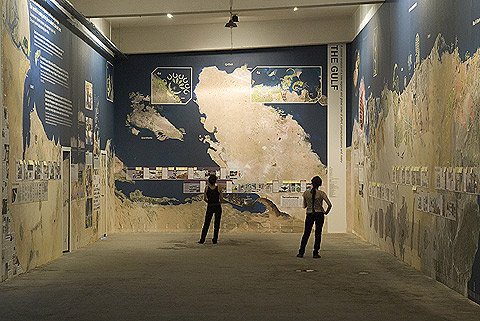Istanbul Foundation for Culture and Arts,
Sep 08, 2007 - Oct 04, 2007
Beyoglu, Istanbul, Turkey
10th Istanbul Biennial Review
by Matthew Schum
The Ataturk Cultural Center (AKM) encapsulated a number of these issues. Located in a central square, the modernist theater is a revered Kemalist-era relic that has been long slated for demolition. The AKM housed Burn It or Not?, an exhibition considering whether this jewel should be preserved for its historical relevance or replaced by a commercial palace. But inside the AKM was a rather benign investigation connecting Turkey to the architectural ghosts of the USSRÑa theme well covered in previous biennials.
This approach suited the AKMÕs communist aura, but it failed to connect Turkish modernism to other cultures beyond former satellite states (the Middle East is one potential example). Slim connections between countries were privileged over an integrated approach to Istanbul: one apparent national surface simply contrasted another.
Something, though, did come through in two local artistsÕ works by the sound piece by outsider musician / artist Erdem Helvacioglu and the video artist Emre HŸner. Something dystopia here upended the gentrification issue in Burn It or Not? Both managed to interface with the baroque modernism in the ornate AKM as the embodiment of something forlorn, that was always doomed from the startÑnot just victim to new development. Helvacioglu and HŸner reached out to Istanbul and its inhabitants in a way that I found the biennial struggled with throughout. The shadow of destruction cast by gentrification was neither sensationalized nor exaggerated; it was pondered from the embedded position. Their work was a kind of scar tissue that occurs before trauma. Envisioning destruction was less of a nightmare that a dreamscape at the center of the city.
A weary pace engulfed the Istanbul TradersÕ Market (IM‚), site of the World FactoryÑa structure quartering family-run businesses in a huge shopping center. The cloistered environment was disarming and made imposters out of conspicuous visitorsÑquite uncomfortably highlighting the contrast between global reality and global art.
World Factory contained a few superb works in this vein nonetheless. The IM‚Õs disconnected installation allowed some to stand alone, negating any relation to other art works (or workers) in their midst. Though secluded, each manifested the conceptual territory of labor underlying this part of the biennial.
With his Informal Economy Vendors, Julio CŽsar Murales was one of few artists that supplemented the bizarre couture aesthetic at the IM‚. Morales appropriates Mexican street art and pushes it to a Constructivist extreme. In the IM‚ this made for an unexpected congruity between the artistÕs graphic wall piece and the charming and hodgepodge storefronts designed by storeowners. Their storefront displays are cutout from the astringent complex and cobbled in isolated windows. Morales created a site-specific piece that capitalized upon the white space framing the entire shopping center.
The workÕs linear and figurative lines combined in a painterly signature that was composed to suggest explosion, like ethereal bodies moving apart. In a rudimentary fashion, this sense of movement activated neglected wall space. Yet, MoralesÕ work rhymed with the existing architectureÕs inexpressive fa?ade and the eccentric window displays by allowing the white walls to invade the graphic tableau (and it clearly did so in a way that would be forbidden to shopkeepers in the orderly association).
Informal Economy Vendors abstracts labor quite literally in the street vendor figure. The freshness of MoralesÕ work was legible as a graffiti writerÕs disdain for the oppressive architecture that frames resident workers (biennial officials celebrated the structure). It was one of a few convincing global connections on display at World Factory, in which an imported aesthetic from afar redirected oneÕs attention to preexisting local sensibilities and spaces of untapped potential.
| 


![Shades of survival / Around me [for AKM] by Els Opsomer](images/tr_serkan_09_md.jpg)





![Shades of survival / Around me [for AKM] by Els Opsomer](images/tr_serkan_09_md.jpg)

